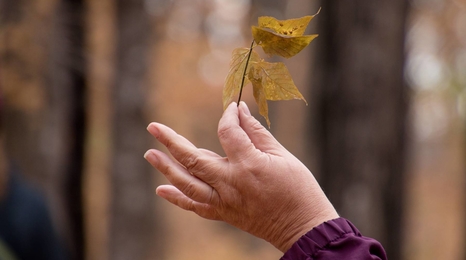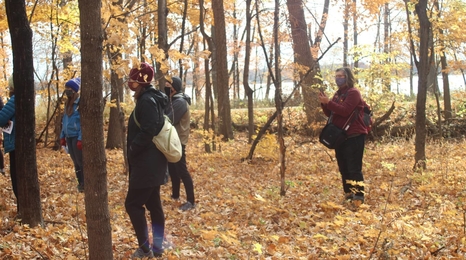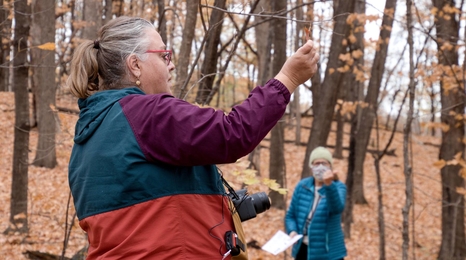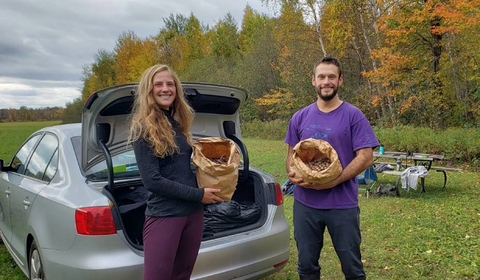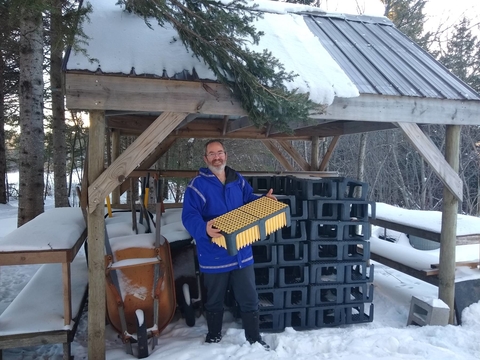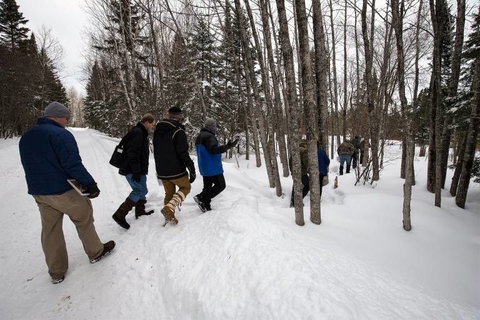As the Northeast RSDP Forest Assisted Migration Project continues and plants its first batch of tree seedlings this year, follow updates and explore resources provided to the growers network on the project’s website.
Average annual temperatures in northeast Minnesota are rising, and the summer growing season is becoming sporadic and unpredictable. These trends threaten the iconic forested landscapes of the Northwoods, as well as the tourism, forestry industry and wildlife that depend on them.
“I am planning to live here and want to make sure I can walk in the woods when I’m old. We’ll need a forest for that,” said Joel Bransky, an AmeriCorps VISTA volunteer with the University of Minnesota Extension Northeast Regional Sustainable Development Partnership (Northeast RSDP).
Planting climate-smart trees can help protect northeast Minnesota’s forested ecosystems from changing conditions. Research from the University of Minnesota Duluth (UMD) and The Nature Conservancy (TNC) has found that increasing the genetic diversity of tree species and growing tree seedlings adapted to warmer climates can improve forest resilience. Trees planted from seeds gathered in central and southern Minnesota are growing healthier and stronger in northeast Minnesota’s rapidly warming climate than those native to northern Minnesota. In the future, while species like red oak and bur oak are predicted to thrive, other native species, such as paper birch, aspen, and black and white spruce, are expected to struggle.
Given this reality, how can land managers and foresters in northeast Minnesota sustainably source diverse tree seedlings better suited to these new conditions?
Growing a market for climate-smart seedlings
With support from Northeast RSDP and a University of Minnesota Institute on the Environment Impact Grant award, the Forest Assisted Migration Project has embarked on a five-year effort to build a regional market for cultivating climate-smart tree seedlings from local farms and nurseries that meet this need.
“We hope we can all be going into this as fully informed as we can be, eyes wide-open, and to build this slowly and deliberately. The best outcome would be a solid market this year, next year, and then long-term, if we’re successful at this,” said David Abazs, Northeast RSDP executive director and project lead.
Since work on this project began last year, its reach has grown, engaging more than 150 people and 30 organizations. UMD undergraduate students Emily Pilz, Alaina Lawrence and Emily Rakos helped with initial outreach to farmers across the region. Since then, a growers network of local farmers and nurseries has formed.
With coordination and support from Abazs, Bransky and Gabrea Francis of the Greater Mille Lacs Sustainable Farming Association (SFA), growers from this network will experiment with growing and selling 40,000 climate-forward tree seedlings to advance forest adaptation and mitigation in northeastern Minnesota. Bransky assisted in collecting some of the seeds volunteers will use from farmers and landowners in central and southern Minnesota.
The project held its first in a series of four trainings for the growers network in December 2020. The recent virtual training included a presentation on farm business planning basics by University of Minnesota Extension educator Ryan Pesch, as well as specific considerations and budget tools for planting tree seedlings.
Partners at TNC agreed to buy and plant the seedlings from the growers network to support the nonprofit’s ongoing climate adaptation efforts in the region.
“Yes, we are talking about loss of the Northwoods as we know it, but working toward a ‘new normal' is worthwhile,” wrote Meredith Cornett, in an earlier article about her and TNC’s work on forest-assisted migration. Cornett is TNC’s Science Director in Minnesota, North Dakota and South Dakota, and a key collaborator on the project.
A branch between research and application
In addition to the applied aspects of this project, the team created a parallel track to explore important research questions about assisted migration strategies, including which traits help tree species have better survival or growth.
Julie Etterson, Ph.D., head of the Department of Biology at University of Minnesota Duluth (UMD) and director of the Institute on the Environment Duluth, is co-leading the project’s research efforts with Briana Gross, Ph.D., associate department head and professor at UMD’s Swenson College of Science and Engineering. Both faculty members are engaging students in their work to provide mentorship and applied research experience.
“I’ve been working on this issue for the past 10 years – doing experimental work with The Nature Conservancy and figuring out whether assisted migration is a good idea. The data has let us know it is. But the reality is there is currently a shortage of climate-smart tree species in our region,” Etterson said. “Now, it’s a delight to work with Northeast RSDP to turn this academic research into an actual economic engine on the ground, translating our academic work to more applied contexts.”
Despite contributing many different roles to the project, members of the Forest Assisted Migration Project team agreed that the goal of their work is to ensure a thriving forest in northeast Minnesota for decades to come.
“Our long-term success will certainly be maintaining a forested region in our state. That is the end goal,” Etterson said.
Those interested in more information about the Northeast RSDP Forest Assisted Migration Project can contact David Abazs and Joel Bransky.
Learn more about the Forest Assisted Migration Project
References
Etterson, Julie R., Meredith W. Cornett, Mark A. White, Laura C. Kavajecz. 2020. “Assisted migration across fixed seed zones detects adaptation lags in two major North American tree species.” Ecological Applications 30(5):e02092. https://doi.org/10.1002/eap.2092.
Frelich, Lee E. 2018. “Report on Forest Vegetation: Analyses portion of ‘Climate Change Adaptation Planning for Northern Forest Ecosystems in the Great Lakes National Parks.’” National Park Service. US Department of the Interior (PMIS 157471).


